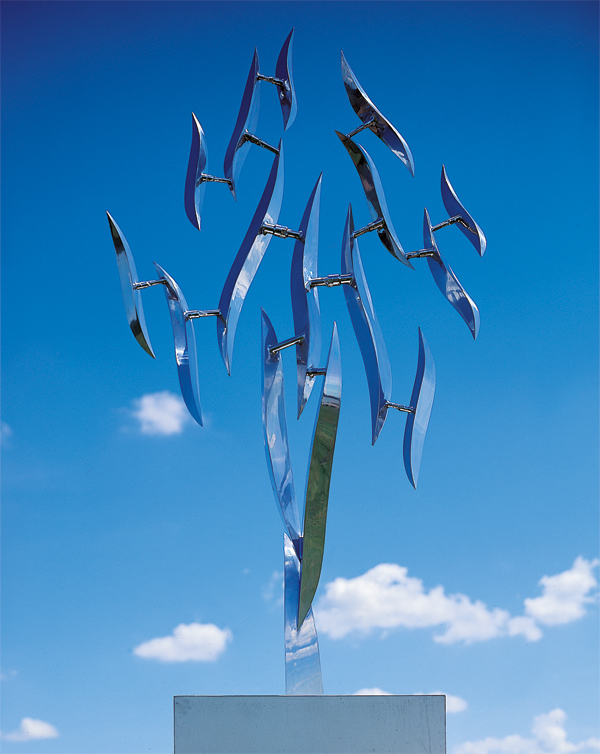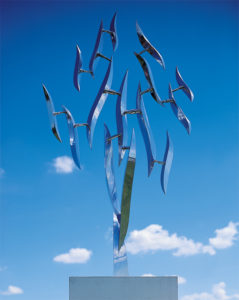Lin Emery
Louisiana artist Lin Emery was best known for her polished aluminum kinetic sculptures in public spaces and collections around the world.

Lin Emery
This photograph shows the model for Lin Emery's "Deva," a 28-foot kinetic sculpture installed in Singapore in 1986.
Lin Emery’s graceful kinetic work is to sculpture what ballet is to dance, a spiritual song to music, or a warm breeze to a summer day. Her delicately balanced monumental polished aluminum creations sway and dance silently in currents of wind much like a sweet fragrance moving silently through a memory. Her work is about grace, form, and motion, with an unspoken spiritual connection between the artist, metal, and nature.
Born in New York City on May 20, 1926, Lin Emery was an internationally acclaimed sculptor who created her kinetic and monumental aluminum compositions in the most sympathetic place—New Orleans. It was a perfect environment for Emery and her work. “I love the natural movement of the trees on the levees, the river, and anything in nature,” she said.
Like her art, Emery’s life was one of motion and was a spiritual journey. Raised in Larchmont, New York, much of her early life was divided between Larchmont and Florida and in the care of an Irish governess who helped tutor her. At age fifteen she entered Columbia University in New York City, followed by a string of other colleges in upstate New York; Mexico; Chicago, Illinois; and finally the Sorbonne in Paris, France, in the late 1940s, all the while studying languages and comparative religions.
Her time in Paris had a profound influence. While at the Sorbonne, she lived across the street from the studio of the famed Russian sculptor Ossip Zadkine (1890–1967). One day Emery wandered into his studio out of curiosity. Zadkine decided to take her on as a student “to show what he could do with a neophyte,” she says. She found that she not only liked sculpture but that she had a natural talent for the medium.
In 1951, Emery returned to New Orleans, where she had briefly lived just after attending the University of Syracuse in New York. There she found considerable work sculpting life-sized religious figures commissioned for churches in the city and throughout the nation. In the changing art world of the 1950s, however, Emery’s interests turned away from her figurative “ecclesiastical” work. She became more interested in abstract designs created through welded metal framework. Of her early works, Emery says, “I was looking for an essence, an interior and searching for understanding.”
Back in the late 1950s and early 1960s, neighbors did not complain when she set up her studio and welding gear in a one-room French Quarter apartment. She finds a similar tolerance to loud hammering and grinding noises that emanate from large studio in uptown New Orleans. “In New Orleans, I can do anything I please,” she says. “New York is so constricting. Also, there is an interaction here between other artists and musicians. There’s not that sense of competition here as in New York. I’ve been able to develop on my own, which I couldn’t do with the pressures of New York. I’ve had time to experiment and fail over and over again.”
Emery acknowledged an understated spirituality in her work. “I have a very deep belief not in any practiced religion but in the search for unity and spiritual understanding,” she said. “I think most of my work is based on spirituality. I once called my pieces Angels, they’re now called Flight.”
In her lifetime Emery’s studio resembled an industrial metal shop. It was filled with drill presses, band saws, metal lathes, polishing wheels, welding tanks, a large electric crane, and scraps that were piled on the floor and stacked just outside the entrance. Her material of choice was polished marine aluminum. “This is a boat-building city and it’s easy to get,” she said. “I can polish it to a mirror finish to reflect nature around it. Bronze could never be polished like that. Aluminum is light and I can carry it around myself.”
Emery’s post-Hurricane Katrina sculptures—she rode out the storm in her home—reflect the angst she and so many other artists experienced during and after the disaster. One polished aluminum piece she called Katrina relates to the “angry water” that destroyed so many lives in the city and region. “It looks angry,” she said. “I often use bright blue or red touches. This will have black.” She described the piece as “much more violent” than her other work, but then so was its inspiration. “The shapes are not soothing,” she continued. “All my work is organic but Katrina has harsh, sharp elements.”
Katrina consists of five kinetic elements delicately pivoted one on top of the other in a symbolic balance of life. The three lower pieces are triangular shaped aluminum wedges that represent the waves and water that destroyed New Orleans and the Mississippi Gulf Coast. The interior spaces of the waves are painted black to represent the death and despair that plagued the region. Two oblong mouth-like elements that extend above the waves represent the cries of people for help during and after the storm.
Emery found her voice in sculpture, whether staging a protest or exploring the subtleties of nature. Over the years, Emery, who loved ballet and music, explored various ways to give an almost theatrical motion to her art through hidden magnets, water, and wind. Today, her mostly wind-powered monumental environmental forms seem suspended between physics and alchemy, intellect and poetry. The elegance and grace in Emery’s work can distract the viewer from the underlying meticulous craftsmanship and mathematical exactness of her industrial-like fabrications.
“Sculpture,” she contended, “is living, it’s vital, it’s changeable. Even when you walk around it, it can be something different. Drawing is a reflection and coordinating eye and hand, but sculpture is your mind and an idea. In sculpture you’re solving problems and making shapes from nothing.” An art critic once described her work as “energies moving through nature.”
Those “energies” have not gone unnoticed, for her list of awards is extensive. She exhibited throughout the United States and in England, Japan, Australia, Germany, and France. In 1996 the New Orleans Museum of Art held a comprehensive retrospective of her work. In 1990, she received the Lazlo Aranyi Award of Honor for Public Art. In 1998, her 30-foot tall kinetic sculpture Honoo No Ki, or Dance of the Tree, which stands in front of the Osaka Dome in Osaka, Japan, received the Grand Prize for Public Sculpture. In Louisiana, her work can be seen at the New Orleans Museum of Art, the Louisiana State Library in Baton Rouge, the Neurological Hospital in Lafayette, the Renaissance Arts Hotel, and the Inter-Continental Hotel in New Orleans, among other locations.
Her work is exhibited in the National Museum of American Art in Washington, D.C.; the New Orleans Museum of Art; the Walter P. Chrysler Museum in Norfolk, Virginia; the Delaware Museum of Art in Wilmington; the Museum of Foreign Art in Sofia, Bulgaria; and the Flint Institute of Art in Michigan. She received the Louisiana Governor’s Arts Award in 2001, an honorary doctorate from Loyola University of New Orleans in 2004, and the National Academy Museum of New York’s S. Simon Sculpture Award. Emery died Thursday, March 11, 2021, at her home in New Orleans
…
